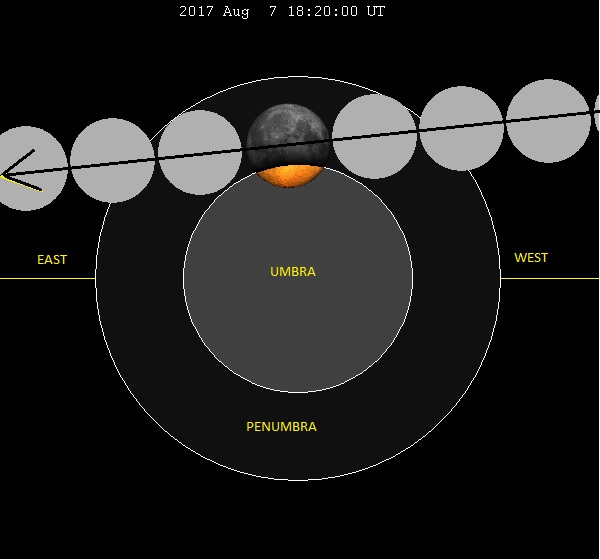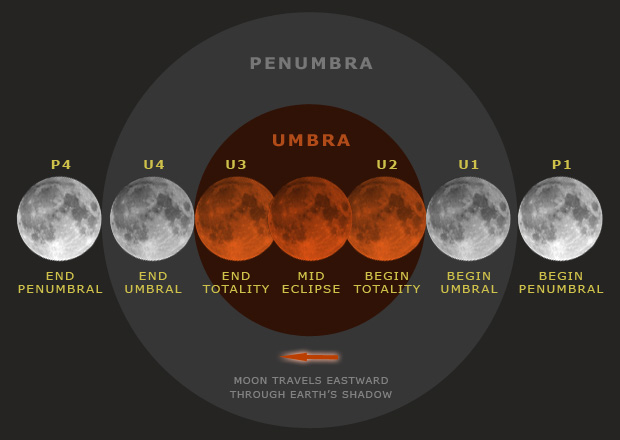
Have you ever heard of the blood moon?
It’s named for its red appearance. Sometimes it’s even mistaken for Mars, as in the case of the “Mars hoax” back in 2002. It was claimed then that Mars would look as large as the full moon on August 27.
In truth, Mars will never appear as large as the full moon to the naked eye (a fancy way of saying that you’re not looking through a telescope or binoculars). What really happened was that the moon passed through the Earth’s shadow.
Wait a second. The Earth has a shadow? And it’s red?
Believe it or not, the Earth’s shadow is actually something you can see yourself.

You’re looking at the bluish haze close to the horizon in this image. This is a particularly pronounced Earth’s shadow. It doesn’t always look this obvious, or this amazing, but you can always see it if you know where to look. You’ll always find it on the horizon opposite the sunset.
What you’re seeing isn’t really that surprising, if you think about it. Every object standing within reach of a light source casts a shadow. The Earth’s shadow, as seen from our surface, is just the dark region of space where our atmosphere isn’t lit up by the sun.
Shadows are simply an absence of light—they appear black. So why does the Earth’s shadow look blue in the photo above…and why does it look red when it falls on the moon?
The Earth’s shadow is blue because the Earth’s atmosphere is an amazing thing, and it scatters the sun’s light. This means the planet’s shadow isn’t pitch black.

Obviously this image is completely off scale—the Earth isn’t even close to that big compared to the sun—but it should help you visualize what’s happening. We see the Earth’s shadow “rising” as the sun sets because this whole diagram basically rotates as the Earth moves into the night.
You can think of the Earth’s shadow as the outer edge of night’s darkness slipping around the curve of the horizon to meet you. Before night falls, you can see the Earth’s shadow on the horizon, rising higher and higher until it blends into the night.
So what does this have to do with lunar eclipses?
Well…there’s one more thing I want to explain about the Earth’s shadow, and maybe then it’ll pop out at you. It appears bluish purple to us when we see it on the horizon, but that’s just because blue light scatters the most easily.
We’ll come back to this in a future post when I talk about the electromagnetic spectrum, which includes visible light. For now, just know that while blue light scatters, red light is better able to penetrate the atmosphere. It’s why the sky is blue—light scatters all over the place.
It’s also why the sunset is red—when the sun is that low on the horizon, it has to pass through more atmosphere to reach your eyes, so only red light makes the journey.
The moon appears red in a lunar eclipse for the same reason.

At night, we can’t see the Earth’s shadow because there’s nothing for it to be cast on. But it would be red, because the sun’s light has had to penetrate a lot of atmosphere to get to the dark side of the planet. Remember, at night, no sunlight reaches you directly.
But when the moon passes through the Earth’s shadow, there’s something for all that red light to fall on. It’s the difference between shining a flashlight straight up into the sky, and onto the ground. And we see the moon bathed in red.
The next logical question is, why doesn’t this happen every month?
It’s a good question. If the moon’s orbit were actually flat with ours, then that’s what would happen. Every full moon, the moon would pass through the Earth’s shadow and we’d get a lunar eclipse.
But that’s not what happens…

The moon’s orbit is tilted a bit. Normally, when full moon happens, the moon is somewhere above or below the Earth’s shadow—and it doesn’t get bathed in red.
But once or twice every year, the moon’s orbit lines up with ours. See, it wobbles a bit, kind of like a spinning top. And when the orbits line up…the moon passes right through our planet’s shadow, and we get an eclipse.
It would be really cool if a total lunar eclipse happened every time the orbits line up. But unfortunately, that’s not the case either. Sometimes, they line up, but not perfectly. The moon might just barely skim the Earth’s shadow, and we get something like this:

Notice that this looks a lot like one of the lunar phases, in that it looks like we’re seeing the nighttime and daytime sides of the moon. But lunar eclipses can only happen during full moon.
For reference, here are the actual phases of the moon.

The darkness in the previous photo of the moon isn’t its nighttime side, it’s the curve of the Earth’s shadow crossing over its daylight side. What’s happening here is this:

This diagram refers to the “umbra” and “penumbra” of the Earth’s shadow. The umbra is simply the darker inner region. The penumbra is technically part of the shadow, but it’s so much brighter that it doesn’t really look like a shadow.
It’s why the eclipse diagramed here won’t be a total one. The only part of the Earth’s shadow that matters for an eclipse is the umbra.
When we get a total lunar eclipse, the moon passes through the umbra entirely. It might not pass through the dead center, but the entire moon will spend some time in the umbra. What happens then is something more like this:

We might also get a penumbral eclipse, which really isn’t that spectacular a sight. That’s what happens if the moon passes through just the penumbra, and not the umbra. Technically, the Earth’s shadow is falling across the moon, but we don’t notice it.
I’ve watched exactly one lunar eclipse in my life, and fortunately, it was total. It was one of the most amazing things I’ve ever seen, and I would encourage you to watch the next one in your part of the world.
Fortunately for North Americans, we’ll get another total lunar eclipse on January 31, 2018. I’ll let you know the specific time when we get closer to the date.
Tomorrow I’ll finish up on eclipses…with the incredible solar eclipse!
Very clear explanation with good pictures and diagrams. We all need a bit of relearning. 🙂 Thanks for sharing!
LikeLiked by 1 person
Thank YOU for commenting!
LikeLiked by 1 person
Brilliantly explained ! Very interesting to read 😇 !
LikeLiked by 1 person
Thank you, glad to hear it!
LikeLiked by 1 person
Reblogged this on Dream Big, Dream Often.
LikeLiked by 1 person
Oh my god thank you! It’s not often people reblog my posts! 😊
LikeLiked by 1 person
You are very welcome!
LikeLiked by 1 person
You are today’s Featured blog!
LikeLiked by 1 person
You just made my day! (Erm, night! For me at least. Lol)
LikeLiked by 1 person
😋😝😁😜
LikeLiked by 1 person